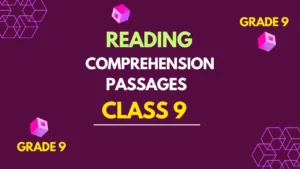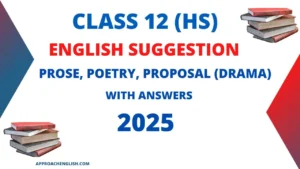In the English language, sentences are the building blocks of communication. They convey meaning, express thoughts, and provide information. In Chapter 2 of the Class 7 curriculum, students delve into the various types of sentences and learn how to identify and use them correctly. This article will provide a comprehensive overview of the kinds of sentences covered in Class 7, along with examples and worksheets to reinforce learning.
Overview of Chapter 2: Kinds of Sentences
In Chapter 2, students will delve into the fundamentals of sentence structure, focusing specifically on the various types of sentences found in the English language. This chapter serves as a foundational building block for understanding how sentences are constructed and how they convey meaning. By the end of this chapter, students will have a clear understanding of declarative, interrogative, imperative, and exclamatory sentences, and their respective functions in communication.
A. Understanding Sentence Structure
In this section, students will learn the basic components of sentence structure. They will explore the roles of subjects, predicates, and other elements that contribute to the formation and clarity of sentences. By understanding sentence structure, students will be better equipped to analyze and construct various types of sentences effectively.
B. Importance of Knowing Different Types of Sentences
Understanding the different types of sentences is crucial for effective communication and writing skills. By knowing how to recognize and use declarative, interrogative, imperative, and exclamatory sentences, individuals can convey their thoughts and ideas more clearly and accurately. Each type of sentence serves a distinct purpose, whether it’s making statements, asking questions, giving commands, or expressing emotions. Mastery of sentence types enhances language proficiency and enables individuals to communicate effectively in various contexts.
Kinds of Sentences
In the study of language, sentences are categorized into different types based on their function and structure. According to function, sentences can be classified into four kinds:
1. declarative,
2. interrogative,
3. imperative,
4. exclamatory.
Each type serves a specific purpose in communication, whether it’s making statements, asking questions, giving commands, or expressing strong emotions.
On the other hand, sentences can also be classified according to their structure, dividing them into three kinds:
1. simple,
2. compound,
3. complex.
Understanding the function and structure of sentences is essential for effective communication and writing.
Kinds of Sentences According to Function
According to function, sentences can be classified into four kinds.
1. Declarative sentences
These sentences state some facts. They are also called assertive sentences. We put a full stop at the end of a declarative sentence.
For example,
- I study in Class VII.
- Ravi likes to play cricket.
- Mahima is cleaning her car.
Declarative sentences are of two kinds – affirmative or positive, and negative.
For example,
- I can play the guitar. (positive)
- I cannot play the guitar. (negative)
2. Interrogative sentences
These sentences ask questions. We put a question mark(‘?’) at the end of an interrogative sentence.
For example,
- When will you come to Delhi?
- Did you like the film?
Interrogative sentences are of four kinds.
a. Yes/no questions
These are questions that need either a yes or a no answer.
For example,
- Are you American?
- No, I am not.
- Do you like ice cream?
- Yes, I do.
b. Wh questions
These are questions that are asked using question words such as who, whom, what, when, where, why, how, which, or whose.
For example,
- What is your name?
- Where do you live?
c. Tag questions
These are interrogative fragments that are added at the end of a declarative or an imperative sentence to form questions.
For example,
- Your pet loves you, doesn’t it?
- They haven’t slept off, have they?
Note: Usually, an affirmative statement has a negative tag and a negative statement has an affirmative tag.
d. Choice Questions
These are questions that provide a choice. The answer to the choice question is in the question itself.
For example,
- Would you like to go to Singapore or Bali?
3. Imperative sentences
These sentences express a request, a command, or a piece of advice.
For example,
- Obey your parents and your teachers.
- Please make some coffee for me.
- You may take the metro upto Rajiv Chowk.
4. Exclamatory sentences
These sentences express sudden emotions and feelings. We put an exclamation mark at the end of exclamatory sentences.
For example,
- What a lovely idea it is!
- How beautiful the parrot is!
Kinds of Sentences According to Structure
According to structure, sentences can be classified into three kinds.
1. Simple sentences
A simple sentence has only one independent clause. It has a subject and a verb and conveys complete sense.
For example,
- I am happy.
- She is learning to swim.
- Father bought a new car.
2. Compound sentences
A compound sentence has two or more independent clauses. The independent clauses are joined by a coordinating conjunction- for, and, nor, but, or, yet or so.
For example,
- I like tea, but she likes coffee.
- She was tired, so she went off to sleep.
Note: You can remember the seven coordinating conjunctions by remembering the following acronym: FANBOYS.
In the acronym, F stands for, A stands for and, N stands for nor, B stands for but, O stands for or, Y stands for yet and S stands for so. She went to the station and bought tickets for the trip.
Remember
The part of a sentence that can stand alone and convey complete sense is called the main, or the independent, clause.
For example,
- She came to my house and went off to sleep.
In this sentence, both the parts (She came to my house + (She) went off to sleep) are independent clauses because both these parts convey complete sense and are independent of each other. The part of a sentence that is dependent on the other part is called the subordinate, or the dependent, clause.
For example,
- Marina had left before I could reach Jisha’s house.
In this sentence, Marina had left can stand independently and be a sentence on its own. But I could reach Jisha’s house cannot stand alone as a complete sentence on its own.
You will learn more about phrases and clauses in Chapter 14 and Chapter 15, respective
3. Complex sentences
A complex sentence has an independent clause and one or more dependent clause /clauses. The two clauses are joined by a subordinating conjunction such as because, that, when, until, though, although, or while.
For example,
- She went out for a walk although it was raining.
- Mary left early because she had to catch a flight early in the morning.
- The train had left before I reached the station.
How to Use the Worksheets
Step-by-Step Instructions
- Read the instructions carefully.
- Identify the task or concept.
- Review the examples.
- Work through each exercise.
- Check your answers.
Tips for Effective Practice
- Practice regularly.
- Start with easy exercises.
- Seek feedback.
- Use a variety of resources.
- Stay consistent.
Practice Worksheets for Kinds of Sentences
A. Identify these sentences and write their kind.
(i) Is it going to snow tomorrow?
(ii) New leaves sprout on trees.
(iii) Please help me.
(vi) When will the program begin?
(v) How wonderfully he sings!
(vi) I won’t follow your advice.
(vii) How many students graduated from this university last year?
(viii) What punishment should be given to the thieves?
(ix) Hurrah! We have won the match.
(x) Turn right at the corner of the temple and wait there till I come.
(xi) Please note the homework in your diary.
(xii) Do you understand Oriya?
(xiii) Which ice cream do you like more-chocolate or vanilla? choice questions
(xiv) Open the door.
(xv) He is playing golf.
Unsolved Worksheets for Types of Sentences
B. Identify the kinds of sentences as simple (S), compound (C), or complex
1. The baby cried for food.
2. Being tired, he went to bed.
3. If you study well, you will pass.
4. The teacher entered the class.
5. I saw a girl who had blue eyes.
6. The earth moves around the sun.
7. He works hard, so he will succeed.
8. The food was hot, so I could not eat.
9. When I was young, we had a lot of pets.
10. While Tom reads novels, Jack reads comics.
11. As it rained heavily, the school was closed.
12. It rained heavily, so the schools were closed.
13. Everyone enjoyed the film, however I did not.
14. Although it rained a lot, they enjoyed themselves.
15. Jigyasa is a teacher and her brother is an engineer.
16. The cat jumped onto the couch and slept on a cushion.
17. My friend has invited me to a party but I don’t want to go to it.
18. Rajni likes reading novels but Priyansh loves reading comics.
19. Although my friend invited me to the party, I do not want to go.
20. She likes to sleep in but she can get up early if she has work.
21. Although I like to go camping, I haven’t had the time to go anywhere lately.
Conclusion
By understanding the structure and usage of declarative, interrogative, imperative, and exclamatory sentences, students can improve their writing and communication skills. With the provided examples and practice worksheets, Class 7 students can enhance their understanding and proficiency in using various sentence types effectively.
FAQs (Frequently Asked Questions)
1. What are declarative sentences?
Declarative sentences make statements or convey information.
2. How do interrogative sentences differ from other types?
Interrogative sentences ask questions and end with a question mark.
3. Can you provide an example of an imperative sentence?
“Please pass the salt” is an example of an imperative sentence.
4. What is the purpose of using exclamatory sentences?
Exclamatory sentences express strong emotions or excitement.
5. Why are practice worksheets important for learning sentence types?
Practice worksheets help reinforce learning and improve retention.







